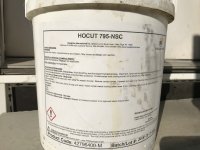I experimented with the mandrel method when shooting the 30 WareWolf (basically a .165 short 308 Lapua) my HBR gun. And no...it was not with any sort of Lee collet die lash up.

Initially, it seemed to show some slight accuracy improvement.
What I was
actually seeing was that the mandrel was a bandaid for how bad the necks
I.D.'s were. They were round but also tapered. Like this, top to bottom (exaggerated, if only obviously

):
After finding that, I made the neck I.D.'s perfectly round the on my fired cases and tested that. The results
on previously neck turned cases was a train wreck. But on new cases, where the neck I.D.'s were made perfectly round
before outside turning....the accuracy was better than it had
ever been especially at 200 yards. Beggar 10's @ 200 became solid 10's and the 'almost-a-10' 9's @ 200 became beggar 10's.

Grand Aggs are won or lost @ 200 and the Grand wins came with more regularity after that.
Since that, inside case neck work became part of my BR case prep routine, carrying over to the 30BR cases and even to the 30 WolfPup with the .085 length neck.
Does every case need it? It depends. If necking up or down, I do it. I did it on my 6PPC with the 220R cases and found nothing with both barrels. But on my 22BR, there was an improvement. My 20 Practical (necked down Lapua 223 cases) shows the same characteristics. I haven't fixed them yet, but I will and will test them next Spring.
I don't compete any more in registered BR tournaments but still consider the case neck I.D.'s to be a critical part of case prep if you're looking for BR level accuracy.
Good shootin'.

-Al





